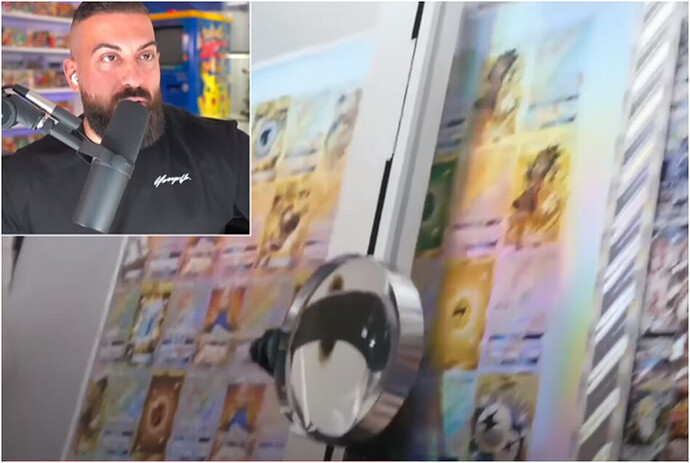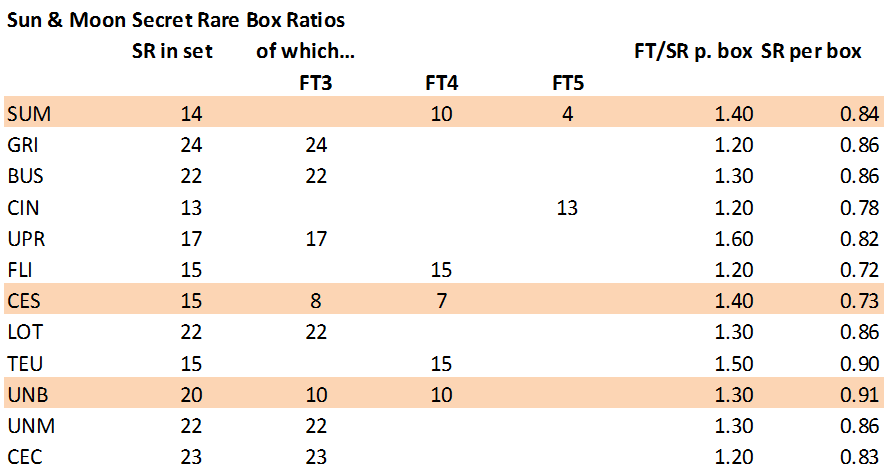Digression: Sun & Moon Series Box Ratios
(Note: I significantly re-wrote this post, changing the sequence length used in the models from 180 to 360 packs.)
Advance note: This topic has already been looked into by E4 member @burpies on a different thread: Pull Rates in Sun & Moon - Sword & Shield Sets. It is great work, and very useful for the models I am developing.
Before looking at the individual sets of the Sun & Moon series, it is a good idea to try and establish what the box ratios - i.e. the number of different types of cards per box on average - are. The assumption I am making is that there is at least some consistency between the sets. For the moment I will focus only on the main sets, of which there are 12, and ignore the special ones. The sets feature the following types of ultra rares:
- “Regular” Pokémon-GX
- Full arts, both of Pokémon-GX and Supporter cards; starting with Team Up, this includes alt arts.
- Secret rares; this includes both rainbow rares and gold-bordered cards featuring items and Energies. One set, Ultra Prism, also features two gold Pokémon-GX, Solgaleo-GX and Lunala-GX.
- Some sets feature “special” cards inserted in the reverse slot, namely all the sets from Ultra Prism to Team Up which feature Prism Star cards, and Cosmic Eclipse which features “Trainer Rares”.
For the XY Series sets starting from Primal Clash, full arts and secret rares appear to have been printed on the same sheet due to evidence from miscuts, as is the case for Black & White Series sets starting with Boundaries Crossed. (For the early XY Series sets, secret rares are assumed to be printed with the regular Pokémon-EX with the exception of the silver Dialga EX card from Phantom Forces.) As to how secret rares and full arts were printed for the Sun & Moon Series, there is a video about how Pokémon cards are produced as evidence (couldn’t find the original, this is from a reaction to it):
If you look at the image, it appears that - unless this is just a test print, which I doubt - at least for Guardians Rising, there is a sheet which contains secret rares (both rainbow rares & items/energies) and full art Trainers, but no full art Pokémon. And this does make sense as if you look at the full art Pokémon, you will notice they reflect the light in lines in a way the full art trainers and secret rares don’t. For more details, see this thread: Question regarding card texturing - Guardians Rising. Many thanks to @ratequaza for the insight provided!
So for the rare slot, I will be assuming five different sheets: non-holo rares, holos, “regular” Pokémon-GX, full art Pokémon-GX (including alt arts) and full art Trainers/secret rares (including gold cards from Ultra Prism).
For the box ratios, there is quite a lot of data around, and I will present data from four different sources here in summary along with how I preliminarily intend to model the sets. I say preliminarily because I won’t rule out something changing when I get around to covering them individually. The sources are:
(1) my own data, compiled from Youtube videos. These are all from complete booster boxes.
(2) the data presented by E4 member @burpies in this thread mentioned at the beginning of this post. The data comes from large openings on Youtube, with the packs being from both booster boxes and other sources.
(3) the data compiled by Youtuber and card store owner Danny Phantump: https://www.youtube.com/watch?v=4TCjfoHoUqk. I am not sure what exactly the source is.
(4) a number of large box openings by Youtuber and card business owner Derium, typically 1,000 packs. They are not necessarily all from booster boxes.
(5) large openings by Youtuber and card business owner TheGameCapital (only for Unbroken Bonds and Unified Minds). For both these sets, there is a slight overlap with my own sample, as he opened one case on camera and I included the pulls in my sample.
From this, I compiled this large table:
Here are some general remarks about the data:
- The columns for full art (FA), full art Trainer (FAT) and secret rare (SR) are in grey because these are not actual sheets. The information is nevertheless important for the purpose of comparing it with Danny Phantump’s data (3).
- I converted the data from @burpies (2) from pack odds to box ratios; the rounding error caused by this is negligeable.
- For Sun & Moon base set, the data from @burpies (2) is identical to that from Derium’s videos (4) so it is obviously compiled from them.
- I can’t be completely sure exactly how many packs were opened in Derium’s videos (4); it seems to generally be 28 boxes (1008 packs), though for Forbidden Light there is mention of 27.7 boxes which would be exactly 1000 packs, and for Unbroken Bonds and Unified Minds it is mentioned that it is in fact 30 boxes (1080 packs). The 2999 (and not) packs for Team Up come from the fact that one pack was shown left sealed as it had an unusual error on the outside.
- For Sun & Moon and for Team Up the Derium data (4) contains the pulls from two different videos, for Guardians Rising from three.
- There is no video by Derium for Cosmic Eclipse.
- Parts of the data are really consistent, such as the ratios for “regular” Pokémon-GX for the earlier sets, but there are also some big outliers, such as the ratio for “regular” Pokémon-GX in Cosmic Eclipse in (3).
For the sequence length which defines the increments for box ratios, I will continue to use 360 in my model, i.e. all box ratios are in steps of 0.1, though this is nothing more than a hypothesis. (In an earlier version of this post, I was using a sequence length of 180, but I ended up running into trouble when it came to accurately modelling the raw data.)
The next step is to look at the combined full art Trainer/secret rares sheet and try to figure out how many slots on the sheet were taken up by secret rares for the various sets, and thus how many secret rares there are per box on average. In the end, this number should be in good agreement with the raw data presented above for the different sets. In order to keep things simple, I tried to go with all secret rares being printed on the sheet an equal number of times - 3 (FT3), 4 (FT4) or 5 (FT5) times - wherever it was possible to do so and get a result that fits the raw data. Where this did not yield a good fit, I instead went with the assumption that all full art trainers are printed on the sheet an equal number of times. The models I am using are shown in the table below:
As can be seen, I am assuming all secret rares are printed on the sheet the same number of times for all sets except three:
- For Sun & Moon Base Set, I am assuming 10 secret rares printed 4 times on the sheet and 4 of them 5 times. That leaves 40 slots for the 4 full art Trainers, each of which would be printed 10 times on the sheet (FT10).
- For Celestial Storm, I am assuming 8 secret rares printed 3 times on the sheet and 7 of them 4 times. That leaves 48 slots for the 8 full art Trainers, each of which would be printed 6 times on the sheet (FT6).
- For Unbroken Bonds, I am assuming 10 secret rares printed 3 times on the sheet and 10 of them 4 times. That leaves 30 slots for the 6 full art Trainers, each of which would be printed 5 times on the sheet (FT5). (Alternatively, it would be possible to model this set with all 6 full art trainers and 16 of the secret rares printed 4 times on the sheet, and the remaining 4 secret rares 3 times. With 1.3 cards from that sheet per box on average, that would however yield 0.99 secret rares per box, which seems too much for me when I consider the observed data.)
In general, these models also lead to fairly similar pull rates for the individual full art Trainers and full art Pokémon, even if they are not printed on the same sheet.
Edit 2024/02/25: Added that the sequence length used to model Ultra Prism is 360 packs and not 180, and that this may me the case in a later revision for Burning Shadows as well.
Edit 2024/03/10: Added the data from Derium’s videos of large Team Up openings.
Edit 2024/03/24: Rewrote post, I am now assuming a sequence length of 360 pack for all sets. This affects the pull rates of Burning Shadows, Lost Thunder, Team Up and Unbroken Bonds.
Edit 2024/04/26: Added further source of data for Unbroken Bonds and Unified Minds (videos by TheGameCapital); changed preliminary model for Unified Minds; added note on alternative model for Unbroken Bonds.


